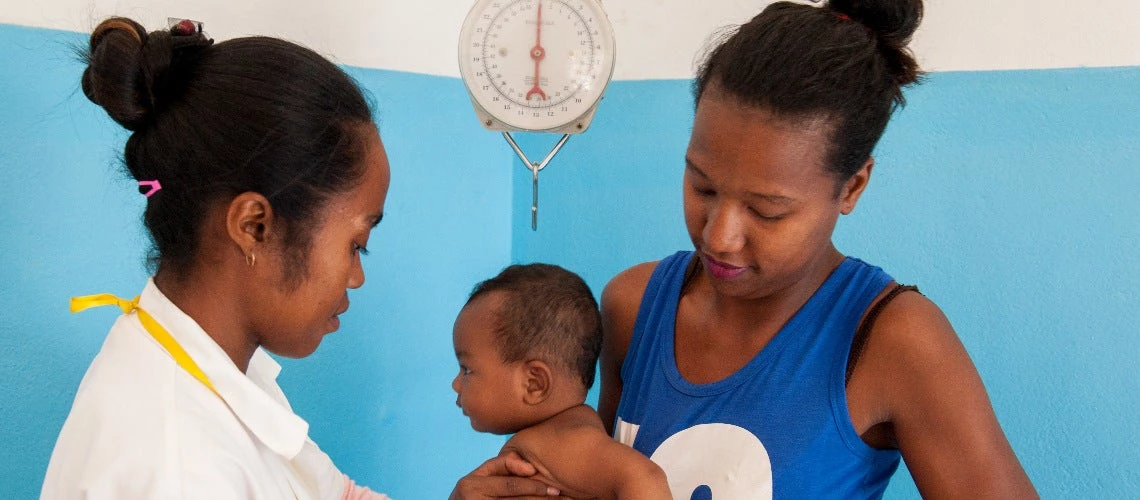 Ensuring that people receive gender-sensitive care is fundamental to achieving high quality primary health care. Copyright: Arne Hoel/World Bank
Ensuring that people receive gender-sensitive care is fundamental to achieving high quality primary health care. Copyright: Arne Hoel/World Bank
Throughout a person’s life, a high-quality primary health care (PHC) system can cover about 80 percent of their health needs and is often the first point of contact for patients with the health system.
Despite its importance, many PHC systems are ineffective in preventing unfair and unnecessary inequalities between genders in health care. A Nature Communications paper published in 2019 showed that among 7 million men and women in the Danish healthcare system, women were diagnosed later than men for more than 700 diseases over a 21-year period.
Gender-responsive measurement tools can help close the gap
Efforts to improve the health of women, adolescents, and children is critical and with the right investments, can eliminate the gender health gap. This includes investments in more comprehensive and inclusive research as well as evidence-based priority setting to improve the access and quality of health care. Yet, in most countries, the system lacks tools—especially gender sensitive and gender responsive measurement tools—to generate the information that health workers can use to understand the different needs of persons of different genders and if they are being met with high quality care.
Gender-sensitive and responsive care is part of person-centered care, which involves a comprehensive approach to health—ensuring that service delivery includes communication, trust, respect for preferences, as well as health education and support for participating in health care decisions. Ensuring that people receive gender-sensitive care is an important factor of person-centered care and fundamental to achieving high quality PHC.
More evidence for a stronger and more inclusive PHC
Generating more information on the needs of individuals to tackle gender bias that leads to discrimination and negatively impacts individuals' well-being is key. For the past five years, the Primary Health Care Initiative (PHCPI) team at the World Bank has worked to promote and strengthen measurement and commitment to PHC, including encouraging better measurement of investments to improve health outcomes, reduce overall system costs to increase access, and reduce inequality for better quality of care.
To build upon this effort, the PHCPI team conducted a scoping review identifying existing and sensitive assessment approaches and summarized their findings in the World Bank Working Paper titled Gender-Responsiveness of Primary Health Care. The review examines nine gender responsive tools, frameworks, and models used to measure different dimensions of PHC at primary and secondary facilities. By measuring the gender sensitivity of service delivery at the primary care level, the systems can improve health care management mechanisms, relations between patients and providers, and eventually quality of care and health outcomes.
Gender assessment tools, frameworks, and models can help in three ways
- Gender assessments and indicators generate data that can be used for advocacy and monitoring of care approach guidelines. For example, data obtained through gender assessments and monitoring might showcase best practices and successful service delivery approaches with measurable results that can be presented to leverage action across the PHC systems. The Adolescent- and Gender-Responsive Health Systems Assessment Tool included in the working paper is a good example of such assessment framework. This tool measures the gender-responsiveness of health services along with assessing national policies and procedures/standards when meeting the health needs and rights of adolescents of all genders over time.
- Gender assessments also enable better planning. The data from these assessments can be used to analyze the services being delivered and help reveal barriers to gender-sensitive health services. They can provide vital information for adjusting programs. For example, the Framework to Measure Women’s Access to Quality Gender-Sensitive Health Services, allows for the collection of patients' experiences related to women’s human rights and gender under specific focus areas such as comprehensiveness of information; comprehensiveness of women’s health services; respect for women’s human rights; infrastructure and facilities; and technical competence of health care providers.
- Gender assessments can also help with intersectional analyses. When providing care, health providers are expected to consider patients' experiences and history. They take into account how different factors of differentiation like ethnicity, gender, race, age, and social class and cultural barriers such as attitudes and practices intersect and interact with each other. Gender-responsive assessment approaches include the intersection of several discriminations in the data collection processes which can be used to raise awareness at multiple levels. The nine frameworks, tools, approaches, and models included in PHCPI's working paper use intersectional approaches in their measurement indicators from considering the providers' and patients' identity to their interaction with health, protection, legal, education, and economic services.
Ensuring person-centered PHC service delivery
Although gender is a structural driver of inequalities in health, a lot remains to be done to generate and use gender assessments. Not measuring needs and services delivered to different genders hinders health workers and implementers’ ability to detect when the system does not adequately provide access to care, improve the efficiency of services, improve clinical outcomes, provide health promotion and self-care as well as reduce overall costs, especially for the most vulnerable population groups. Effectively assessing if primary health care services are gender-responsive (or gender-sensitive) indicates where health systems fail to integrate a person-centered care approach.
Evidence-based treatment approaches tailored to meet individuals’ needs are nearly unattainable without tools, frameworks, and models that can measure gender (in)equality or (in)justice including elements essential for an effective service provision at the primary care facility level.
PHC systems are central to health equity. Unarguably, there is a need to promote primary health care that is gender-sensitive for various population groups to help address gender-based health inequalities.
To receive weekly articles, sign-up here




Join the Conversation